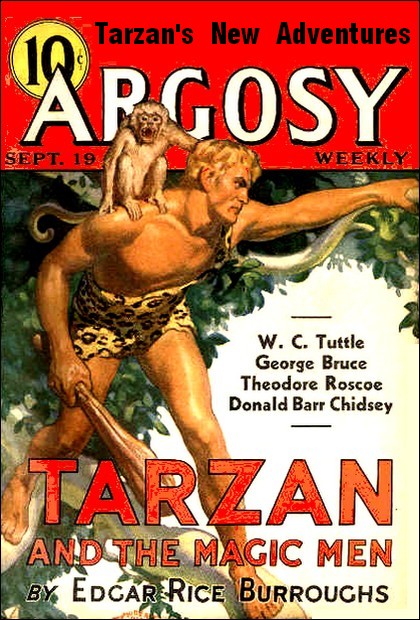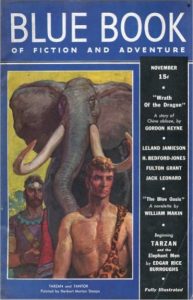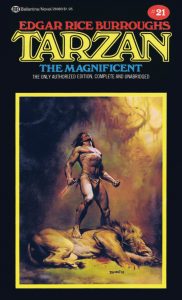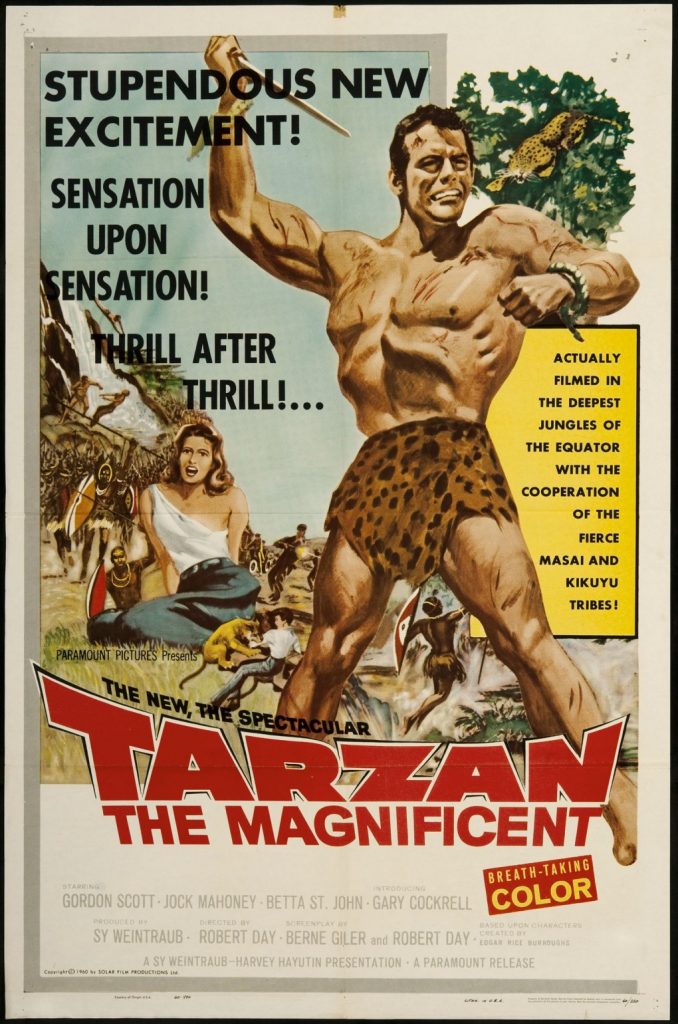 Tarzan the Magnificent is actually two stories originally published separately; Tarzan and the Magic Men was published as a three part serial in the pages of Argosy Weekly in 1936 while Tarzan and the Elephant Men was a three part serial published in the pages of Blue Book between the years 1937 and 1938. The duality of Tarzan the Magnificent doesn’t end there as in the first story it deals with evil twins ruling two separate city states, and then in Tarzan and the Elephant Men
we return to the Cathne, the City of Gold and it’s waring neighbour
Athne the City of Ivory, which we were first introduced to back in Tarzan and the City of Gold. The two stories were combined to form the novel Tarzan the Magnificent in 1939.
Tarzan the Magnificent is actually two stories originally published separately; Tarzan and the Magic Men was published as a three part serial in the pages of Argosy Weekly in 1936 while Tarzan and the Elephant Men was a three part serial published in the pages of Blue Book between the years 1937 and 1938. The duality of Tarzan the Magnificent doesn’t end there as in the first story it deals with evil twins ruling two separate city states, and then in Tarzan and the Elephant Men
we return to the Cathne, the City of Gold and it’s waring neighbour
Athne the City of Ivory, which we were first introduced to back in Tarzan and the City of Gold. The two stories were combined to form the novel Tarzan the Magnificent in 1939.The book begins with Tarzan discovering an old skeleton that had in its possession a letter from Lord Mountford who had disappeared, along with his pregnant wife, two decades ago. Mountford’s letter tells of his capture by the wild women of the Kaji, their occult powers, and how his wife was put to death after giving birth to a girl. Having heard of this famous missing persons case Tarzan decides to bring the letter to the local authorities, but before he can do so he spots Ska the vulture circling new prey and he goes to investigate. It’s here where Tarzan encounters Stanley Wood, a travel writer who when found raves deliriously about a beautiful woman, a she-devil, and a diamond. Once refreshed with food and water he is able to tell Tarzan of how his party was captured by the Kaji, an amazon women controlled city but one ruled by the evil wizard Mafka, a man who can control minds with the use of a great diamond. The Kaji society isn’t one of the better thought out creations of Burroughs; the women of this city where originally of black African descent but now they only mate with white men, mostly from passing safaris, and they kill off any child that shows a trace of their black ancestry. Why do these women want to “cleanse” themselves of their African heritage? Not a clue, Burroughs gives no explanation for this.
Tarzan tries to take Wood back to civilization but the mental powers of Mafka are too strong and one morning Tarzan wakes up to find the man gone. The interesting thing to take note of here is that Tarzan is completely immune to the psychic powers of Mafka, one assumes his being raised by animals has changed his brain chemistry in such a way as to be resistant to something the rest of us would fall prey to. Not one to let mental abduction of a friend slide Tarzan proceeds to enter the valley to confront this so called magician king. Needless to say things don’t go as planned for any hidden valley in a Burroughs book wouldn’t be worth its salt if it didn’t have a rival city, and is into the hands of Zuli warriors that Tarzan runs into first. The Ape Man meets the cruel magician Woora, the identical twin brother of Mafka who has his own mind controlling gem. Woora thinks Tarzan is a Kaji spy and has him locked up and sentenced to die. Not killing Tarzan immediately is the downfall of many villains, and with the aid of a fellow prisoner Tarzan escapes with the Zuli mind controlling emerald. Tarzan’s escape aided by his ablility to use the emerald to control the Zuli warriors who pursue him, that is until one morning he wakes up to find that his ex-prison mate has absconded with the emerald.
While Tarzan is trying to track the thief down he is captured by the women warriors of Kaji and imprisoned, but he quickly escapes when he discovers a secret passageway hidden in a never-been-used-fireplace located in his cell. It’s while exploring this passageway that Tarzan runs into Gonfala, Queen of the Kaji. She is also the woman that Wood informed Tarzan that he was in love with and who helped him to escape, but his warning of her quick change of nature from sweet girl to she-devil was very warranted. After getting Gonfala to agree to help him and Wood escape she suddenly turns viscous and calls for the guards. Later we learn that Mafka’s psychic control of the poor girl is the cause of her Jekyll and Hyde personality, and when the evil magician meets his end she is finally free of it and join her true love Stanley Wood.
Any happy ending must be postponed as there are some touchy problems with Wood and Gonfala’s relationship; some of the members of Wood’s safari point out that though Gonfala is white with blonde hair she still has black blood in her, and a white man just does not marry a black girl. Wood could not care less what ethnicity or race his beloved Gonfala belongs to, but when she over hears some of the men, and one particular racist bastard’s “nigger” comments, she races off into the night. Eventually after some more heroic encounters and savage dangers the two lovers meet again, and Wood makes it clear to Gonfala that he loves no matter what her heritage is. This is a nice progressive attitude for a man of the early 20th Century and I wish Burroughs had ended it there, but Gonfala then produces a letter that her father gave her many years ago to deliver to the Colonial Office in London, and in the letter they discover that Gonfala is actually the daughter of Lord Mountford. So no black blood "taints" her dainty personage. *sigh* Burroughs did this before in The Cave Girl where a man of social standing was going to marry the pretty savage girl, despite her primitive background, but then at the end it was revealed that the cave girl was the daughter of Eugenie Marie Celeste de la Valois, Countess of Crecy.
The second half of the book deals with Tarzan returning to The City of Gold. The idiot racist members of Woods expedition find themselves lost in cannibal country, and though they have the diamond they can’t seem to utilize its powers. Their brilliant plan is to then kidnap Gonfala, get her to use the mind powers of the gem, and then carve out a new society with them in charge. These guys aren’t what you would call good planners. How they ever expected to get a kidnap victim to use a mind controlling device to aid them, opposed to Gonfala turning it on the jackasses who grabbed her, is beyond me. These idiots spend most of their time fighting amongst themselves until they are eventually captured by the Elephant Men of Athne. Meanwhile both Tarzan and Wood are searching for Gonfala, in separate direction, which leads to the Ape Man reaching Cathne, the City of Gold while Wood actually manages to make it to Athne where his true love is being held captive by a mad king.
Unfortunately for Tarzan and friends both of these cities have come under new management; everyone is enslaved, Tarzan ends up in the arena…again, and cruel and evil rulers order the deaths of all concerned. Will Tarzan be able to escape a city full of treacherous assholes? Can the love of Gonfala and Wood triumph? And will that rogue elephant that Tarzan rescued from a pit trap earlier in the story play into the big finale? Well if you’ve read one of these book before you know the answer to all those questions, but once again Burroughs is able to dress up his own overused tropes to make another fun and exciting adventure. Some of the racist elements of the story may be a bit off-putting to younger readers, but it is a good snapshot of the people of that time, and shows how society today hasn’t improved all that much since then. Though I found the first half of the book a bit clunky the return to the City of Gold more than made up for it, and thus I can easily recommend this book to you.
Note: Several times characters in this book would comment, "That guy is a regular Tarzan!" after seeing Tarzan perform some amazing jungle feat, not realizing the person they are watching is the real deal. As was revealed in Tarzan and the Lion Man most people in the world consider Tarzan to be a myth, kind of like Africa's version of Bigfoot. What's cool is Tarzan does nothing to dispel this belief.




No comments:
Post a Comment